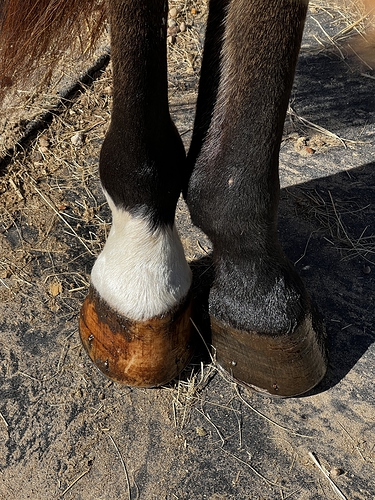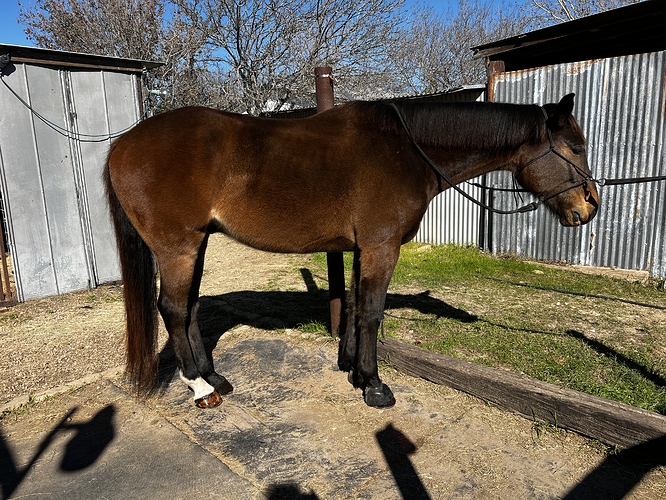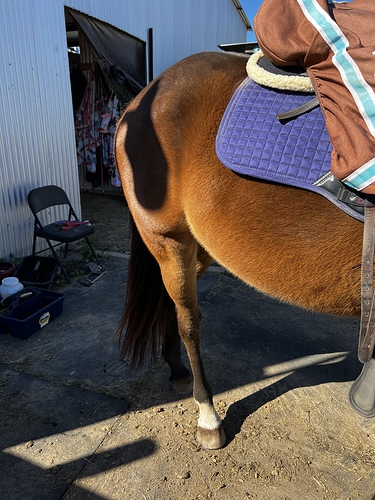Lots of questions to answer hopefully I can remember them all.
As for it being too short of a time to heal the suspensory I agree. When I started researching this condition people said bare minimum 6 months to a year. I was surprised to be back trotting so fast. And when I did start to trot I was expecting there to be a difference in his way of going but there wasn’t. No different with shoes, all the therapies, adequan, stall rest, etc. I definitely don’t mind giving it more time. I wouldn’t even mind tossing him out for a year to just sit in a pasture. He’s not one to really go crazy turned out. Sometimes he gets the zoomies but he definitely doesn’t when he doesn’t feel good.
I’m uploading a video of his Suspensory ultrasound to put here. It’s a screen recording on my phone and I flip through it kind of fast because at least on an iPhone you can pause and take your time to look. So for those who are really interested you can look and if you know how to read ultrasounds that’s even better.
For the rest of us I will include the language used in his discharge report that says what’s on the ultrasound.
Spankie’s Ultrasound
“ Diagnostic Tests & Results:
Hoof Testers: No response on all feet
Lameness Exam: There was no lameness at a walk on hard ground. There was a mild, consistent (grade 3/5) right hindlimb lameness at a trot in a straight line. The right hindlimb lameness was exacerbated and a mild, intermittent (grade 1/5) left forelimb lameness became apparent when circling to the left. The Lameness Locator confirmed the presence of the mild, RH lameness.
Flexions: LF Lower: 0/3 LH Lower: 1/3
LH Upper: 1+/3 Diagnostic Analgesia:
RF Lower: 0/3 (no response)
RH Lower: 1/3 (mild response)
RH Upper: 2/3 (moderate response)
RH Low 4-point Nerve Block: mild improvement in right hindlimb lameness
RH Deep Branch of the Lateral Plantar Nerve Block: significant improvement in the right
hindlimb lameness. After this block a mild left hindlimb lameness became apparent.
Ultrasound: Ultrasound examination of both metatarsal regions was performed and revealed mild to moderate, bilateral proximal suspensory desmitis characterized by mild increase in size of both proximal suspensory ligaments, moderate proximal suspensory fiber pattern disruption of the left hind proximal suspensory ligament. There was also evidence of mild, chronic suspensory branch desmitis (medial and lateral LH, and medial RH).
Radiographs:
Left hind digit: The dorsal soft tissues are equal in thickness at the proximal and distal aspects of the hoof wall. The dorsal soft tissue thickness to plantar cortical length ratio is normal (0.28). The plantar angle is slightly positive. There is adequate sole depth at the toe. The remaining imaged osseous and soft tissue structures are unremarkable.
Right hind digit: The dorsal soft tissues are equal in thickness at the proximal and distal aspects of the hoof wall. The dorsal soft tissue thickness to plantar cortical length ratio is normal (0.29). The plantar angle is neutral. There is adequate sole depth at the toe. There is mild osteophytosis at the dorsoproximal aspect of the middle phalanx, mildly progressive from the referral exam. The remaining imaged osseous and soft tissue structures are unremarkable.
Conclusions:
- Minimal right pelvic limb proximal interphalangeal joint osteoarthritis, which is of uncertain clinical significance.
- Otherwise unremarkable bilateral pelvic limb digits on this limited exam.
Page 2
Diagnosis: Bilateral hind proximal suspensory desmitis
Bilateral hind suspensory branch desmitis, mild, chronic
Treatment:
- Total sedation: detomidine (3 mg IV)
- Polysulfated Glycosaminoglycan (5mg IM): first dose administered on the left neck 3. PRP (platelet rich plasma) periligamentous injection, both hind proximal suspensories
- Shockwave therapy (bilateral hind proximal suspensory ligament):
1,000 pulses per site with 35mm power probe at E8
- Bandage: distal limb bandage applied on both hindlimbs over injection sites 6. Anti-inflammatory: phenylbutazone ( 2 g IV)
Instructions to Owner
Medications:
Adequan (Polysulfated Glycosaminoglycan): Give 5mL in the muscle every 4 days for a total of 7 treatments. Next dose is due 11/01/23. For maximum benefit, we recommend that this dosing series be repeated every 6 months.
Dormosedan Gel: Give as instructed by the label for sedation for shoeing.
Bandages: Please remove the bandages in 2 days, or sooner if they become excessively soiled, wet, or slip on his legs.
Housing and Exercise: Spankie should be rested in a stall or stall with run with controlled exercise twice a day. Please avoid large pasture turnout to decrease the chance of excessive activity or re-injury. Spankie should have hand or ridden walk for 5-10 minutes once to twice daily for the next week. The time spent walking should be increased by 5 minutes per week until his next recheck exam.
Farrier: You may consider shoeing Spankie with a suspensory support shoe on both hind feet. This may include a shoe with wide bar and a mild heel extension / trailer to provide support to his suspensory apparatus. The shoes should be reset every 4-6 weeks.
Diet: Spankie may continue his normal diet and ration.
Call If: You notice increased lameness, heat, pain, or swelling around injection sites or
if you have any question or concerns about Spankie.
Additional Instructions: As discussed, rest and active rehabilitation should be prioritized to allow proper healing of Spankie’s suspensory ligament injury, but there are additional options that could help improve quality of healing. Today, Spankie was started on a course of Adequan injections. In addition, today Spankie had an injection of Platelet Rich Plasma (PRP) surrounding each proximal suspensory ligament and shockwave therapy. PRP therapeutic injections provide anti-inflammatory effects and
Page 3
promote healing. Shockwave therapy provides analgesic effects and also promotes healing where soft tissues attach to the bone, like at the proximal suspensory region. We anticipate that Spankie may require 4-6 months of walk and trot exercise before being released to a gradual return to full work.”
Here is the follow up report from his 1 month check up on 12/1/23
“ Hoof Testers: No response on any limb.
Lameness Exam: There was no lameness at a walk on hard ground. There was a mild, right hind lameness observed in a straight line and when circling to the left (mild grade 3/5) that was moderately improved from his prior exam on subjective assessment. When circled at a trot in hand over hard ground, a mild forelimb lameness became apparent when circling either direction (grade 2 RF and LF).
Comparison Lameness Locator assessment revealed resolution of the RH pushoff lameness identified at his prior exam. On soft ground, the right hindlimb lameness was moderately improved and the bilateral forelimb lameness was not appreciated.
Diagnosis: Bilateral hind proximal suspensory desmitis (historic, improving) Bilateral hind suspensory branch desmitis (historic, chronic)
Housing & Exercise: Please continue to stall rest Spankie with controlled exercise twice a day. Please avoid large pasture turnout to decrease the chance of excessive activity or re-injury. Spankie should have ridden walking exercise once to twice daily, as possible, for 20 minutes. The time spent walking should increased by 5 minutes weekly. After the next 2 weeks of ridden walking exercise, you may introduce 3-5 minutes of trot into the middle of his walking exercise. The time spent trotting may increase by 3-5 minutes weekly for the following month. If at any point Spankie shows increased lameness or resistance to move forward, please reduce his exercise (time and / or intensity).
Diet: Spankie may continue his normal diet and ration.
Call If: You notice increased lameness or if you have any concerns about Spankie.
Additional Instructions: We discussed Spankie’s positive progress today and the plan to continue with his rehabilitation program. Cold hosing or back-on-track hock wraps may be used. Please continue to monitor Spankie’s progress as he progresses to increased work and let us know if you have any concerns. If you notice increased or worsened lameness at any time after introducing trot exercise, please reduce to walk only and schedule a recheck exam. We are hopeful that after a positive recheck exam again in 6 weeks (after 2 weeks ridden walk and 4 weeks ridden walk and trot) that we will repeat his ultrasound exam and may find Spankie ready to continue to increase ridden work and consider larger turnout.”
The past 2 days during our walks he has been naturally forward, ears pricked, minimal tension, and offered me trot. I went with him at his own slow pace and let him stop when he wanted to which was only 10-15 seconds. Yesterday he was feeling really good and in a positive way, workman like. We did some trotting and if he swished his tail or I felt tension I brought him back to walk until he was relaxed again. I sent this video to his vet and she said “ His trot looks good. Sounds like you are doing the right thing. As we talked about during the first visit, there will also be some behavioral / mental resistance issues to work through and it can be hard to completely separate those from pain. Going slow, but being persistent is important. We will make sure we check his back closely at his next visit. Until then… keep it up!”
Spankie Trot 12/28
I texted her previously that “just for my peace of mind I need have his back examined more thoroughly”
I don’t think his pain and acting out is behavioral or mental. I can see certain horse show venues where that might be an issue due to negative experiences and memories but he responds very well to confidence EQ. If I only have a sound and happy horse in certain conditions then he’s not sound imo. I don’t think a sound horse would suddenly be incredibly reactive when he gets emotional and insecure in a situation. I don’t think even natural tension in a sound horse would create the kind of reactivity he displays. He definitely acts like his back hurts and it’s not a saddle fit issue or ulcers.
I’m including video from his lameness exam in October and the one month follow up in December.
Lameness Exam Comparison
Thanks for taking the time to take an interest in us and help us and providing your experience and opinions. It really does take a village.






